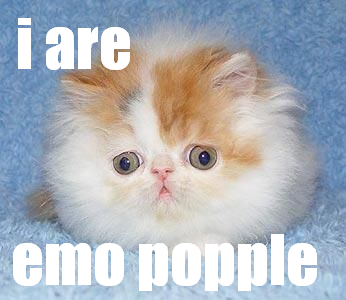 |
| I sense... a TPK |
Running a successful tabletop RPG involves quite a bit of future-telling. When I prepare to hunker down behind the screen, I often find myself trying (and less often, succeeding) to anticipate how the upcoming game session will play out. There is a fine line every GM must walk between a game that feels like a movie about trains and a game that feels like... well... um... what do you guys do next?
I am still refining my methods for achieving the zen-like balance between well-crafted story and player-driven experience, and I occasionally wobble to one side or the other, but I have learned a few tricks to keep things from toppling into the abyss.
1. Know thy players and their PCs: One of the first things I try to do when designing an encounter or longer adventure is to approach the problem from my players' point of view. How will they try to solve this? If it is a fight, the sorceress will likely try to kill things with fire, the wizard will lay down AoE spells to hamper the enemy, the whole party will be hasted ASAP and the monk will charge in with fists flying. If the situation calls for sneaking, the rogue will use her ridiculous move silently, disguise and hide bonuses. If there is an obstinate NPC to win over, the bard will step in.
Understanding how your players operate (standard tactics, abilities, etc.) is a good first step, but can often feel frustrating, especially when trying to devise something that will actually present a challenge. I have come to the realization that it is much easier to run a campaign for low-level characters. Now that my group is around level 10, they have so many tools at their disposal that it is difficult to challenge them. Why slog across country for a week when you could teleport?
2. Know the rules: When designing a session, I find it is very valuable to brush up on the rules that are likely to come into play during each encounter. Clifftop fight? Review bull rush, falling damage and climb checks. Bargaining with the king? brush up on the rules for changing attitude and perhaps some of the softer spells like charm person or zone of truth
3. Personality goes a long way: This may not work for everyone, but I find that if I understand my NPCs' goals, favored tactics and personalities, I often don't need to flesh out the anticipated details of how a scene will play. I used to fear roleplaying encounters, but now find them much easier to prep than site-based events such as dungeon crawls, because all I need are a couple note cards and a willingness to act the part.
4. There are no wrong answers: or right answers for that matter. Last week, this idea really hit home as I watched my players wrestle with how to get into a city with heavily restricted access. They weighed options from disguising themselves as beggars, to a traveling show, to the Wookie subterfuge, to just offering to join the army. Eventually they realized that they have the ability to make themselves invisible, but the discussion around the table became a scene unto itself. This helped me realize that I don't always have to have an ideal solution in mind... which, while refreshing, can make it all the more difficult to anticipate the PC's next move.
Fellow GMs, do you have any tried and true techniques for ensuring strong preparation without railroading?
Separate, random question: How would you adjudicate a spell-caster who used Web to break his or her fall (i.e. blasting a magic safety net below) after falling from a particularly high spot?








